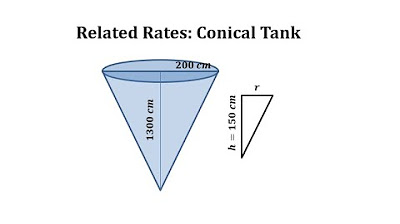Related Rates and a Trapezoidal Trough
TLDRThis educational video script explores the concept of derivatives in calculus by solving a real-world problem. It involves calculating the rate at which the water level rises in a 10-meter long water trough with an isosceles trapezoidal cross-section. The trough is filled at a constant rate of 0.2 cubic meters per minute. The script meticulously details the process of converting measurements into meters, finding the area of the trapezoidal cross-section, and using the volume formula to relate it to the water level height. It then uses derivatives to find the rate of change of the water level when it is 30 centimeters deep, resulting in a final answer of 3.3 centimeters per minute, showcasing the practical application of calculus in understanding rates of change.
Takeaways
- 📏 The water trough is 10 meters long with a cross-section shaped like an isosceles trapezoid.
- 📐 The trapezoid's dimensions are 30 cm wide at the bottom, 80 cm wide at the top, and 50 cm in height.
- 💧 The trough is being filled with water at a rate of 0.2 cubic meters per minute.
- 🔍 The goal is to find the rate at which the water level is rising when the water is 30 cm deep.
- 📚 The volume of the water in the trough is calculated by multiplying the area of the trapezoidal cross-section by the length of the trough.
- 📉 All measurements are converted to meters for consistency, resulting in 0.3 meters for width at the bottom, 0.8 meters at the top, and 0.5 meters for height.
- 🔍 The area of the trapezoid is found by using the properties of similar triangles and the isosceles nature of the trapezoid.
- 📈 The volume formula for the water in the trough is derived as V = 10h(3 + 5h), where h is the height of the water.
- 🔄 The derivative of the volume with respect to time is taken to find the rate of change of the water level, resulting in V' = 3h' + 10hh'.
- ⏱ By solving for h', the rate of change of the water level with respect to time is found to be h' = V' / (3 + 10h).
- ✂️ At a water depth of 30 cm (0.3 meters), the rate of water level rise is calculated to be 1/30 meters per minute, or approximately 3.3 centimeters per minute.
Q & A
What is the shape of the cross-section of the water trough described in the script?
-The cross-section of the water trough is an isosceles trapezoid.
What are the dimensions of the water trough's cross-section in centimeters?
-The cross-section is 30 centimeters wide at the bottom, 80 centimeters wide at the top, and has a height of 50 centimeters.
How is the width at the top of the water trough related to the width at the bottom in terms of the isosceles trapezoid property?
-In an isosceles trapezoid, the non-parallel sides are congruent. The width at the top is 80 centimeters, and the width at the bottom is 30 centimeters, which means the two non-parallel sides (the legs of the trapezoid) are each 25 centimeters long (80 - 30 = 50, then 50 / 2 = 25).
What is the length of the water trough in meters?
-The water trough is 10 meters long.
At what rate is the water being filled in the trough in cubic meters per minute?
-The water is being filled at a rate of 0.2 cubic meters per minute.
What is the purpose of converting all measurements to meters in the script?
-Converting all measurements to meters helps to avoid calculation errors due to unit mismatch, as the volume rate is given in cubic meters per minute.
How is the volume of the water in the trough related to the height of the water?
-The volume of the water in the trough is directly related to the height of the water. The volume can be calculated by multiplying the area of the trapezoidal cross-section by the length of the trough.
What is the formula for the volume of the water in the trough when the water level is at a certain height?
-The volume of the water in the trough is given by the formula V = 10 * (h * (0.3 + 0.5h)), where h is the height of the water in meters.
What does the derivative of the volume with respect to time represent?
-The derivative of the volume with respect to time (V') represents the rate at which the volume of water in the trough is changing per minute, which is the given rate of 0.2 cubic meters per minute.
How is the rate of change of the water level (h') calculated when the water is 30 centimeters deep?
-The rate of change of the water level (h') when the water is 30 centimeters (0.3 meters) deep is calculated by dividing the rate of volume change (0.2 cubic meters per minute) by the derivative of the volume formula with respect to height, which simplifies to h' = 0.2 / (3 + 3h).
What is the rate at which the water level is rising when the water is 30 centimeters deep?
-When the water is 30 centimeters deep, the water level is rising at a rate of approximately 3.3 centimeters per minute.
Outlines
💧 Calculating Water Level Rise in a Trapezoidal Trough
The video script discusses a problem involving a water trough that is 10 meters long with a cross-section shaped like an isosceles trapezoid. The trapezoid has a bottom width of 30 cm, a top width of 80 cm, and a height of 50 cm. The trough is being filled with water at a rate of 0.2 cubic meters per minute. The goal is to determine how fast the water level is rising when the water is 30 cm deep. The script explains the need to find the relationship between the volume of water and the height of the water level (h). It introduces the concept of derivatives to measure rates of change, specifically the rate of change of the water level with respect to time. The volume of the water in the trough is calculated by multiplying the area of the trapezoidal cross-section by the length of the trough. The script also highlights the importance of converting all measurements to the same unit (meters) to avoid calculation errors.
📏 Deriving the Rate of Water Level Rise Using Geometry
This paragraph continues the discussion by focusing on finding the area of the trapezoidal cross-section to relate it to the volume of water. The script uses the properties of an isosceles trapezoid to simplify the calculation by transforming it into a rectangle. It sets up a proportion using similar triangles to find the relationship between the unknown side 'a' and the height 'h' of the trapezoid. The script solves for 'a' and finds it to be half of 'h'. The volume formula for the trough is then simplified to a function of 'h'. The script then takes the derivative of this volume with respect to time to find the rate of change of the water level (h'). Finally, it solves for 'h' prime (the rate of change of the water level with respect to time) when the water depth is 30 cm, which is converted to 0.3 meters for consistency. The final calculation yields the rate of water level rise as 3.3 centimeters per minute, providing a complete solution to the problem presented in the video script.
Mindmap
Keywords
💡Water Trough
💡Isosceles Trapezoid
💡Volume
💡Derivative
💡Rate of Change
💡Cross-Sectional Area
💡Similar Triangles
💡Proportionality
💡Integration and Differentiation
💡Units Conversion
Highlights
A water trough is modeled as a trapezoidal prism with a length of 10 meters.
The cross-section of the trough is an isosceles trapezoid with specific width and height measurements.
The trough is being filled with water at a rate of 0.2 cubic meters per minute.
The concept of derivatives is introduced to determine the rate of change of the water level.
The volume of the water in the trough is related to the area of the trapezoidal cross-section.
The volume of a prism is calculated as the area of a single face times the length of the prism.
All measurements are converted to meters for consistency in calculations.
The area of the trapezoidal cross-section is derived using properties of isosceles trapezoids.
Similar triangles are used to find the relationship between the height and the non-parallel sides of the trapezoid.
The volume of water in the trough is expressed as a function of the water level height.
The derivative of the volume with respect to time is calculated to find the rate of water level rise.
The relationship between the volume derivative and the height derivative is established.
The specific rate of water level rise is solved when the water depth is 30 centimeters.
The final calculation results in a water level rise of 3.3 centimeters per minute at the specified depth.
The problem demonstrates the practical application of derivatives in real-world scenarios.
The solution process involves a combination of geometric understanding and calculus.
The importance of unit consistency in mathematical modeling is highlighted.
Transcripts
Browse More Related Video
5.0 / 5 (0 votes)
Thanks for rating:





